
Catalog excerpts
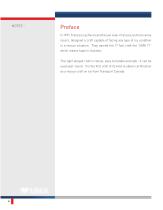
Preface In 1997, François Lachance and his son Jean-François, both ice canoe. racers, designed a craft capable of facing any type of icy condition in a rescue situation. They named the 17 foot craft the “UMA 17” which means hope in Inuktitut. This light alloyed craft is robust, easy to handle and safe. It can be used year-round. It is the first craft of its kind to obtain certification as a rescue craft on ice from Transport Canada.
Open the catalog to page 4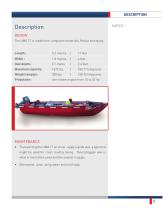
DESCRIPTION Description DESiGN The UMA 17 is made from composite materials; Kevlar and epoxy. Length: Width : Hull depth : Maximum capacity: Weight (empty): Propulsion : MAiNTENANCE • Transporting the UMA 17 on snow : apply a glide wax, a type that might be used for cross country skiing . Toko toboggan wax is what is most often used and the easiest to apply • Afterwards, clean using water and mild soap
Open the catalog to page 5
DESCRIPTION notes : Nautical terms Port: Left side of the craft when looking ahead. Right side of the craft when looking ahead. The rear part of the craft. The vertical portion forming the rear of the craft. The height of a craft’s hull above the waterline. Found at the water level, when the craft is immobile and on calm water. Manning and Equipment: The materials necessary to properly operate a craft. Helm: Helmsman: Person responsible for operating the motor. In, at, or toward the source of a stream. Used to steer the rudder of the craft.
Open the catalog to page 6
The UMA 17 is a craft that can be used year round, in any sort of water condition. It is easy to use when launching ramps are not available or when ice is a factor. Crew and their roles The ideal crew in the UMA 17 would be comprised of a helmsman, an officer and 2 rescue crew members. It is strongly suggested that all crew members receive training for the UMA 17.
Open the catalog to page 7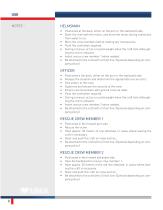
HELMSMAN • Positioned at the back, either on the port or the starboard side . • Steer the craft with the motor, and move the motor during transitions from water to ice • Warn the crew members before making any manoeuvres . • Push the craft when required . • During a rescue, act as a counterweight when the craft Lists while getting the victim onboard • Assist rescue crew member 1 when needed . • Be attached to the craft with a 5 foot line . (Optional depending on company policy) OFFiCER • Positioned a the back, either on the port or the starboard side • AnaLyse the situation and determine...
Open the catalog to page 8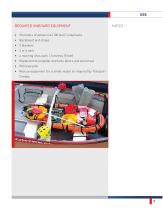
USE Required onboard equipment • 30 meters of yellow line (100 feet) / snaphooks • Backboard and straps • 2 blankets • 2 or 4 oars • 4 mooring lines each 1.5 metres (5 feet) • Replacement propeller and tools (pliers and wrenches) • Retrieval pole • Rescue equipment for a small vessel as required by Tran
Open the catalog to page 9
GENERAL SECURiTY RULES AH crew members must wear a full body rescue suit . • MSD900 immersion suit (or another approved model) . • Knife • Strobe light • Whistle • Gloves • Hood • Helmet and headlamp • Harness and snaphooks • Boots • Clip crampons for boots • Transmitter-receiver (officer)
Open the catalog to page 10
Manoeuvring Crew members should always be attached to the craft in case they are required to distance themselves from the craft. The foot of the motor should always be in the unlocked position in order to ensure its freedom of movement for transitioning between water and ice. The motor should always be cut when the craft reaches the victim in order to avoid any injuries. The foot of the motor should be lifted so as to not get caught between two pieces of ice. In order to avoid injury to crew members, the helmsman should alert crew members to any brusque movements on the water or when...
Open the catalog to page 11
Manoeuvring notes : Manoeuvring methods On a trailer When moving the craft on a trailer, it is recommended to use an outboard motor support in order to avoid any damage to the motor. Hoisting The UMA 17 is equipped with 3 hoisting rings in order to hoist it onto a vessel or move it in general. To properly hoist the UMA 17, 3 approved lines must be used; 1 at the bow and 2 at the stern. This tested and approved method allows for the craft and its equipment to be hoisted in a safe and stable manner.
Open the catalog to page 12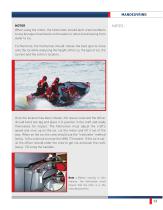
Manoeuvring Motor When using the motor, the helmsman should alert crew members to any brusque movements on the water or when transitioning from water to ice. Furthermore, the helmsman should choose the best spot to move onto the ice while analysing the height of the ice, the type of ice, the current and the victim’s location. Once the location has been chosen, the rescue crew and the officer. should bend one leg and place it in position in the craft and ready themselves for impact. The helmsman must adjust the craft’s speed and once up on the ice, cut the motor and lift it out of the way....
Open the catalog to page 13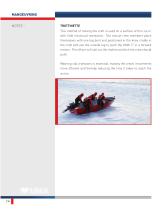
This method of moving the craft is used on a surface of thin ice or with little structural resistance . The rescue crew members place themselves with one leg bent and positioned in the knee cradle in the craft and use the outside leg to push the UMA 17 in a forward motion . The officer will call out the rhythm at which the crew should push Wearing clip crampons is essential, making the crews' movements more efficient and thereby reducing the time it takes to reach the victim .
Open the catalog to page 14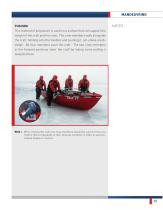
Manoeuvring Pushing This method of propulsion is used on a surface that can support the weight of the craft and the crew. The crew members walk alongside the craft, holding onto the handles and pushing it, not unlike a bobsleigh. All four members push the craft. The two crew members in the forward positions steer the craft by taking turns pulling it towards them. Note : When moving the craft, the crew members should be sure to move at a rhythm that corresponds to their physical condition in order to avoid excessive fatigue or injuries.
Open the catalog to page 15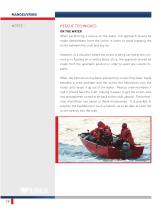
Manoeuvring notes : Rescue techniques On the water When performing a rescue on the water, the approach should be made downstream from the victim in order to avoid trapping the victim between the craft and any ice. However, in a situation where the victim is being carried by the current or is floating on or with a block of ice, the approach should be made from the upstream position in order to avoid any violent impacts. When the helmsman has been advised that contact has been made between a crew member and the victim, the helmsman cuts the motor and raises it up out of the water. Rescue crew...
Open the catalog to page 16All UMA Boat catalogs and brochures
-
UMA17
1 Pages


